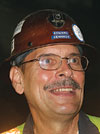 Melissa Traynor / ENR |
 Melissa Traynor / ENR One mile-long tunnel is completed and the other will be done by fall.
|
A pair of tunnel-boring machines has almost completed the main mile-long bore between Manhattan’s east side and Queens for the Metropolitan Transportation Authority’s $7.2-billion East Side Access project. One 22-ft-diameter drive is now completed and the other will be done by the end of summer, say MTA officials.
The entire project, due for completion in 2015, will bring Long Island Rail Road trains directly into Grand Central Terminal through the new tunnels. LIRR commuters currently can only get into Manhattan via Pennsylvania Station on the West Side.
The TBMs, built by Robbins Co., Solon, Ohio, worked on average 140 ft below street level. They bored through hard bedrock from 63rd Street and Second Avenue west for four blocks, then turned south toward Grand Central at 42nd Street—and beyond to 39th Street to create a train storage area.
 |
| KENNEDY |
The joint venture of Dragados USA, a unit of Madrid-based ACS Group and Judlau Contracting Inc., College Point, N.Y., won the $428-million contract for the tunnels in 2006.
In 2007, the first TBM was lowered in pieces down a shaft, onto railcars, taken to an assembly chamber at the 63rd Street site and put together, says Edward Kennedy, senior tunneling engineer for MTA’s Capital Construction Co. The second TBM was mostly assembled in Queens early this year, attached to dollies and “walked” in 8,600 ft on the rail tracks at 7 ft per hour, Kennedy adds. When it reached its assembly chamber, awaiting it were 10 components to be bolted and pinned, including gripper shoes and four outer sections of the cutter head.
|
Each TBM requires 3 MW of power. They sent excavated material back out to Queens on a 8,600-ft-long linked conveyor belt. The average rate of excavation is 30 ft per day.
Crews are now backing out the first TBM about 800 ft toward the site of a $736-million contract, also held by Judlau/Dragados. There, workers are now drilling and blasting cross-passages for a 1,200-ft-long, 75-ft-wide cavern that will house LIRR’s future station platforms beneath Grand Central. The main tunnels are about 12 ft apart at the crossover point. Each TBM will build two miles of auxiliary tunnels.
| + click to enlarge |
 |
After tunnel excavation, workers install layers of shotcrete plus waterproof membrane followed by cast-in-place concrete. “A precast liner was a contract option that was dropped just before the project began,” says Kennedy. “Now, we use rock bolts, and where needed, ring beams and straps.”
ESA received $2.63 billion under a Federal Transit Administration Full Funding Grant Agreement last year, but still needs almost $3 billion. “The worst thing would be to lose momentum on a job of this magnitude,” says Joseph Trainor, MTA program executive. A contract for Queens tunnels in soft earth using earth-pressure-balance machines will be let this fall.
 Video:
Video: 
Post a comment to this article
Report Abusive Comment